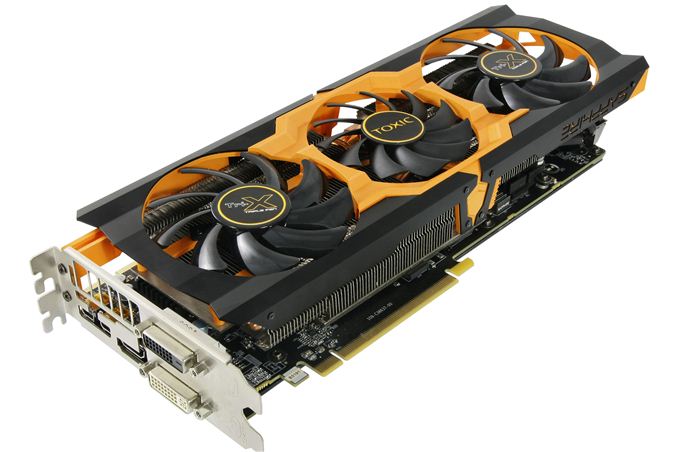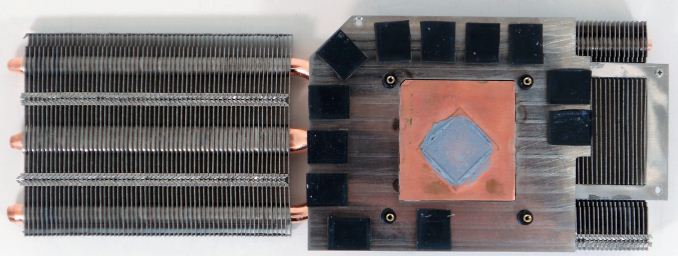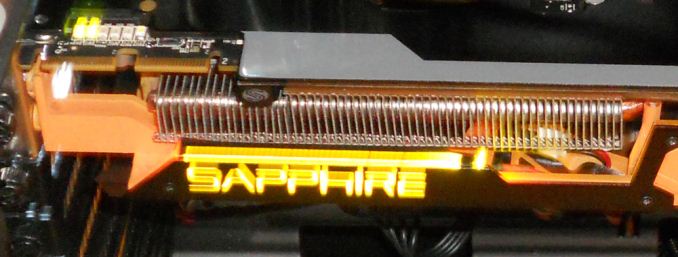The Sapphire R9 280X Toxic Review
by Ryan Smith on October 10, 2013 8:00 AM EST- Posted in
- GPUs
- Radeon
- Sapphire
- Tahiti
- Radeon 200

With AMD’s Radeon R9 280X being based on the company’s now venerable and battle-tested Tahiti GPU, AMD’s partners have wasted no time in releasing fully customized products for AMD’s new lineup. Whether it’s reusing a tried and true design from the 7970 and 7970 GHz Edtion, or coming out with a new design entirely, everyone is doing something to make their card unique. In fact you won’t even find a reference card for the 280X launch; everything is custom from day one.
Of course it’s not just boards and coolers that can be adjusted. With nearly 2 years knowledge on the performance characteristics and yield curves of the Tahiti GPU, partners aren’t wasting any time in releasing aggressively clocked designs in their first salvo. We’ve already seen Asus make their first move with their R9 280X DirectCU II TOP, and they won’t be alone. But of all the designs being released in the next week for the 280X, none that we’re aware of are quite as aggressive as what Sapphire will be going for with their 280X Toxic.
| AMD GPU Specification Comparison | ||||||
| Sapphire R9 280X Toxic | Asus Radeon R9 280X DCU II TOP | AMD Radeon HD R9 280X | AMD Radeon HD 7970 GHz Edition | |||
| Stream Processors | 2048 | 2048 | 2048 | 2048 | ||
| Texture Units | 128 | 128 | 128 | 128 | ||
| ROPs | 32 | 32 | 32 | 32 | ||
| Core Clock | 1100MHz | 970MHz | 850MHz | 1000MHz | ||
| Boost Clock | 1150MHz | 1070MHz | 1000MHz | 1050MHz | ||
| Memory Clock | 6.4GHz GDDR5 | 6.4GHz GDDR5 | 6GHz GDDR5 | 6GHz GDDR5 | ||
| VRAM | 3GB | 3GB | 3GB | 3GB | ||
| Typical Board Power | >250W | >250W | 250W | 250W | ||
| Width | Double Slot | Double Slot | Double Slot | Double Slot | ||
| Length | 12.25" | 11.25" | N/A | N/A | ||
| Warranty | 2 Years | 3 Years | N/A | N/A | ||
| MSRP | $349 | $309 | $299 | N/A | ||
Meet The Sapphire R9 280X Toxic
Clocked at 1100MHz for the base GPU clock and 1150MHz boost GPU clock, with the their 280X Toxic Sapphire is aiming to have the fastest 280X card on the market. This is 250MHz (29%!) faster than the stock 280X at base clockspeeds, and 150Mhz (15%) faster under full boost. This is a very high and very narrow range of clockspeeds that according to the various 280X card specs we have so far makes the 280X Toxic the highest clocked card on the market, and one that will always be performing very close to its peak clockspeeds thanks to that narrow boost range. To that end 1150MHz is by no means unheard of for a Tahiti overclock, but by our reckoning it is towards the tail end of what a good Tahiti GPU can do under a reasonable voltage and air cooling, so Sapphire dipping well into the tail end of the yield curve to bring this card together. In any case, complementing the GPU overclock is a smaller memory overclock of 400MHz (7%) to keep the GPU fed.
Meanwhile cooling Sapphire’s highly clocked beast is a new cooler design out of Sapphire that is not necessarily the largest of the dual-slot GPU coolers, but certainly among the longest at 12.25 inches. Dubbed the Tri-X cooler, Sapphire is using a 3 fan asymmetrical design that takes a pair of 90mm fans with an 80mm fan in the center to provide all of the airflow the card needs. In that respect this is fairly typical for a triple fan open air cooler, though making Sapphire one of only a couple of companies to use this design in any product in lieu of a dual fan design.
Located below and measuring just a bit shorter than the fan-shroud is the 280X Toxic’s heatsink, a two segment vertical fin design. Sapphire is using 5 copper heatpipes to move heat between the GPU and the heatsink, with two pipes going to the first segment located over the GPU while the other three go to the segment at the tail end of the card, with the largest of these heatpipes measuring 10mm in diameter and tying it for the largest heatpipes we’ve seen yet.
Pulling away the heatsink we can find a couple of other heatsinks and a baseplate to pick up the slack for what the primary heatsink can’t cover alone. A baseplate attached to the larger heatsink segment provides cooling for the Hynix RAM chips and other discrete components around the GPU, while another strip heatsink is attached to the MOSFETs that are part of the card’s voltage regulation equipment. This smaller heatsink isn’t attached to the primary heatsink in any way, so cooling comes off of the airflow from the fans.
On the back side of the card we’ll find a backplate that Sapphire has attached to the card and runs the full length of the PCB. There aren’t any components on the back of the card that the backplate provides direct cooling for, but it does provide another heat outlet for the MOSFETs on the front of the card, with a strip of thermal material connecting the backplate to the location on the PCB where the MOSFETs are. The backplate also provides some protection for the chokes Sapphire has placed on the back of the card, as the backplate sticks out farther than the chokes. Meanwhile for those who like to show off or otherwise have their video card visible, on the back we’ll also find Sapphire’s LED temperature LEDs, a series of 6 LEDs that will light up in accordance with the GPU temperature.















84 Comments
View All Comments
EmperorRosko - Friday, October 11, 2013 - link
I really think you need to step back and read your comment. You make no sense whatsoever other than sounding like you are a complete and utter green team excitable mess because a card like this nearly beats a stupidly overpriced card like the 780.The reason they have put a stock GTX780 in the test (which even the vanilla card costs 499 UK POUNDS!!!!) is just to show that a card that costs as low as 260 quid is biting at its heels, of course a customised 780 is going to take another 10% lead but this test is just to show that if you are in the market for a 770/780, this card is something you should seriously considering before dropping cash nVidia's way!
No to mention that when Mantle drops for BF4, this card will more than likely blow a 770/780 out the water anyway and for that game a 290x wont be necessary to hold a massive frame rate.
just4U - Saturday, October 12, 2013 - link
When reviewing cards they usually throw them up against stock variants for comparison.mwildtech - Thursday, October 10, 2013 - link
Sucks this card has no overclock-ability, but at it's price point it makes a stock GTX 780 look like a horrible buy. I know the GTX 780 overclocks like a beast, so It can take a 30% lead pretty easily with an avg OC, but still it's $649 dollars.VaporX - Thursday, October 10, 2013 - link
mwildtech, Overclocking is a hit and miss in every product, especially one that is out of the box clocked at higher values than the competition can often overclock to. That being said two other reviews where able to get some very solid overclocks.MrSpadge - Thursday, October 10, 2013 - link
Agreed - if the card can't even stand 10 MHz more, it will loose stability at stock clocks as soon as the chip degrades a little - which happens exponentially faster with more voltage..just4U - Saturday, October 12, 2013 - link
that's one of my problems with overclocked cards.. I really don't trust them at all and simply prefer a stock card I can screw around with.. give it a great cooler and I am happy..jerrylzy - Saturday, October 12, 2013 - link
I think it can. mine 7970 can stand 1200/1700commissar0617 - Saturday, October 12, 2013 - link
my sapphire 7970/oc has overclock ability. after I change the TIM, i will probably be able to get it to 1.1ghzMombasa69 - Monday, October 14, 2013 - link
It comes with an OC utility....Mombasa69 - Monday, October 14, 2013 - link
Check out bjorn3d(dot)comMentions the OC Utility.